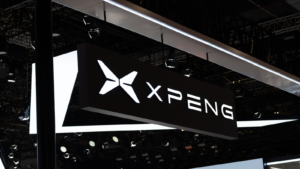
With EV prices dropping, analysts say two-thirds of global auto sales could be EVs by 2030. All of which is great news for EV stocks. In fact, according to Rocky Mountain Institute (RMI), “battery costs should halve this decade, from $151 per kilowatt hour (kWh) in 2022 to between $60 and $90 per kWh, making EVs ‘for the first time as cheap to buy as petrol cars in every market by 2030 as well as cheaper to run.’”
As I’ve said before, if the world really wants to fuel further EV adoption, it needs to get aggressive with EV charging infrastructure. Right now, that severe shortage of EV charging stations will only continue to limit EV sales. However, once the issue is resolved, EV sales could easily accelerate, especially with nearly half of Americans interested in an EV.
That being said, investors may want to jump into EV stocks, such as:
EV Stocks: Tesla (TSLA)

The industry’s 800 lb. gorilla, Tesla (NASDAQ:TSLA), is currently consolidating around $212 a share. From here, I’d like to see it retest resistance around $300 again, with patience.
I admit, earnings were pitiful, but don’t write it off just yet. With the EV boom only set to accelerate, Tesla will eventually be a standout winner again. Unfortunately, EPS of 66 cents missed expectations of 73 cents. Revenue of $23.35 billion was also below estimates of $24.1 billion. This is also the first time TSLA missed on earnings and revenue since 2019, according to CNBC.
With regards to its Cybertruck, “CEO Elon Musk tempered financial expectations for the vehicle, saying, ‘It is going to require immense work to reach volume production and be cashflow positive at a price that people can afford. I just want to temper expectations for Cybertruck. It’s a great product, but financially, it will take a year to 18 months before it is a significant positive cashflow contributor.’”
BYD Co. (BYDDF)

Or, take a look at BYD Co. (OTCMKTS:BYDDF).
Doing far better than Tesla, BYD Co. just said quarterly profits could double on record sales. In fact, it now expects to post a third-quarter profit of “CNY9.55 billion ($1.31 billion) to CNY11.55 billion, up from CNY5.72 billion a year earlier.” That follows news the company’s EV sales were up 67% to 431,603 units in the third quarter. It also puts BYD one step closer to overtaking Tesla, whose sales fell to 435,059 from 466,140 year over year, according to Morningstar.
Even better, Bernstein analysts also initiated coverage of BYD with an outperform rating. They believe BYD will be one of the top EV automakers in the world. Technically, after running from about $24 to a high of $36, BYD Co. has seen some recent profit taking. However, with strong sales growth, I believe it could retest $36 again soon. Longer-term, I’d like to see it retest $42.
EV Stocks: Li Auto (LI)

Li Auto (NASDAQ:LI) is another hot EV to consider, with blistering delivery numbers. In August, company sales were up about 664% year over year to 34,914. In September, deliveries were up about 213% year over year to 36,060. That also pushed its third-quarter deliveries to 105,108, or 296.3% growth year over year. Moreover, Citi analysts recently raised their price target on LI to $65 from $54.30 a share, with a buy rating. Bank of America also raised its price target to $60 from $56.
Moving forward, the company says it will reach or surpass the 40,000 per month mark by the fourth quarter. Plus, as noted on its latest earnings call, “Another important point to note is we’re very confident that we will be able to challenge the leadership position of Mercedes (OTCMKTS:MBGYY), BMW (OTCMKTS:BMWYY), and Audi in China, meaning that we’ll exceed their sales in China and become the top-selling luxury brand in China,” as noted by Insider Monkey.
After exploding from about $17 to $47.50, Li Auto is seeing some profit taking. However, if the company can maintain its year-over-year delivery growth, it could again revisit resistance at $47.50 shortly.
XPeng (XPEV)

There’s also XPeng (NYSE:XPEV), which just delivered a record 15,310 Smart EVs in September. Those numbers were up 12% month over month and 81% year over year. In August, it delivered 13,690 of them, an increase of 24% month over month and 43% year over year. In addition, total Smart EV deliveries for the third quarter jumped to 40,008, a quarter-over-quarter increase of 72%.
Helping, as I noted earlier this month, “Volkswagen (OTCMKTS:VWAGY) invested $700 million into XPEV to help boost sales. Reportedly, the two companies will develop two mid-sized VW-branded EVs for the Chinese market, with plans to roll them out by 2026.” Better, the company has plans to aggressively expand into Europe, including Germany, Britain, and France, in the new year. And according to Bank of America analysts, the company could turn a profit in 2025, as compared to a net loss in the firm’s prior forecast. All thanks to its recent deal with Volkswagen.
XPEV last traded at $14.25 a share. From here, I’d like to see it retest resistance around $19 again soon.
EV Stocks: Krane Shares Electric Vehicles and Future Mobility ETF (KARS)

Another smart way to invest in electric vehicles is with an ETF, such as the Krane Shares Electric Vehicles and Future Mobility ETF (NYSEARCA:KARS). Not only does it allow you to diversify with top EV names, but it also allows you to do so inexpensively.
With an expense ratio of 0.72%, the KARS ETF holds stocks involved with electric vehicle production, autonomous driving, shared mobility, lithium and copper production, and hydrogen fuel. Some of its top holdings include Tesla, Aptiv (NYSE:APTV), Panasonic Holdings (OTCMKTS:PCRFY), Li Auto, Albemarle (NYSE:ALB), and BYD Co., to name a few of the top ones.
At the moment, KARS is oversold at $26.87. It’s also over-extended on RSI, MACD, and Williams’ %R. From here, I’d like to see KARS run back to $34 again soon.
Global X Autonomous & Electric Vehicles ETF (DRIV)

Or look at the Global X Autonomous & Electric Vehicles ETF (NASDAQ:DRIV). With an expense ratio of 0.68%, the ETF invests in companies involved with autonomous vehicles and technology, EVs, and EV components and materials, including lithium and cobalt. Some of its top holdings include Alphabet (NASDAQ:GOOG, NASDAQ:GOOGL), Nvidia (NASDAQ:NVDA), Toyota Motor (NYSE:TM), Apple (NASDAQ:AAPL), Qualcomm (NASDAQ:QCOM), and Tesla.
The DRIV ETF is also oversold at the moment. The ETF appears to have caught strong support after dropping from about $27.67 to $22.90. From here, I’d like to see it retest $27.67 again.
Global X Lithium & Battery Tech ETF (LIT)

There’s also the Global X Lithium & Battery Tech ETF (NYSEARCA:LIT), which should benefit from heavy demand for lithium. After all, without lithium, we can’t build EVs or have the green future that countries are demanding.
With an expense ratio of 0.75%, the LIT ETF invests in the full lithium cycle, from mining and refining the metal through battery production. Some of its top holdings include Albemarle, Panasonic, BYD Co., Tesla, Livent Corp. (NYSE:LTHM), Piedmont Lithium (NASDAQ:PLL), and Standard Lithium (NYSEMKT:SLI).
Currently, the LIT ETF is also considerably oversold at $52.09. From here, I’d like to see the ETF again challenge $60 a share soon.
On the date of publication, Ian Cooper did not hold (directly or indirectly) any positions in the securities mentioned. The opinions expressed in this article are those of the writer, subject to the InvestorPlace.com Publishing Guidelines.





